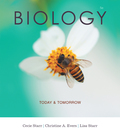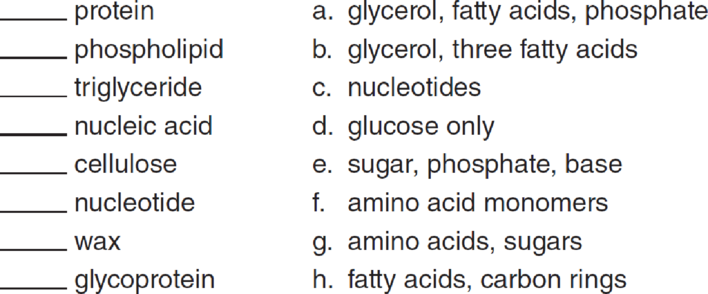
EBK BIOLOGY TODAY AND TOMORROW WITH PHY
5th Edition
ISBN: 9781337509572
Author: STARR
Publisher: YUZU
expand_more
expand_more
format_list_bulleted
Concept explainers
Textbook Question
Chapter 2, Problem 15SQ
Match each molecule with its component(s).

Expert Solution & Answer
Trending nowThis is a popular solution!

Students have asked these similar questions
what measures can a mother to take to improve the produce of her to milk to her newborn baby ?
1. Color the line that represents all ancestors of the Eastern white pine tree green (but only the ancestral line NOT shared with other organisms)
2. Oncle the last common ancestor of the Colorado blue spruce tree and Eastern white pine tree.
3. Put a box around the last common ancestor of the sugar maple tree and the dogwood tree.
4. Put a triangle around the last common ancestor of the red pine tree and the american holly bush.
5. Color the line that represents all ancestors of the Ponderosa pine tree red (including all shared ancestors).
6. Color the line that represents all ancestors of the American elm tree blue (including all shared ancestors).
7 Color the line that represents all ancestors of the Sabal palm tree purple (including all shared ancestors)
8. Using a yellow highlighter or colored pencil, circle the clade that includes all pine trees.
9. Using a orange highlighter or colored pencil, circle the clade that includes all gymnosperms
10. Can you tell…
You have been hired as a public relations specialist to give invertebrates a good name. After all, they are much more than just creepy crawly bugs!
Your first task though is to convince yourself that is true. The best way to do that is to start close to home. Find something in your house that is a product obtained directly from an invertebrate or only due to an invertebrate’s actions. Describe the product, its function and utility, as well as any human manufactured alternatives. Be sure to highlight the advantages of obtaining this directly from nature.
Keep in mind, a product can be something you use, wear, eat, or enjoy for its visual appeal.
Chapter 2 Solutions
EBK BIOLOGY TODAY AND TOMORROW WITH PHY
Ch. 2 - A. The first shell corresponds to the first energy...Ch. 2 - B. A chlorine atom (Cl) becomes a negatively...Ch. 2 - Figure 2.12 A pH scale. Here, red dots signify...Ch. 2 - Figure 2.17 Fatty acids. Double bonds in the tails...Ch. 2 - Effects of Dietary Fats on Lipoprotein Levels...Ch. 2 - Effects of Dietary Fats on Lipoprotein Levels...Ch. 2 - Effects of Dietary Fats on Lipoprotein Levels...Ch. 2 - Prob. 1SQCh. 2 - Which element has only one proton?Ch. 2 - The mutual attraction of opposite charges holds...
Ch. 2 - A salt does not release __________ in water. a....Ch. 2 - A(n) _______ substance repels water. a. acidic b....Ch. 2 - When dissolved in water, a(n) _____ donates H+ and...Ch. 2 - _________ is a monosaccharide. a. Glucose b....Ch. 2 - Unlike saturated fatty acids, the tails of...Ch. 2 - Which of the following is a class of molecules...Ch. 2 - Prob. 10SQCh. 2 - Prob. 11SQCh. 2 - Prob. 12SQCh. 2 - Prob. 13SQCh. 2 - Match the molecules with the best description.Ch. 2 - Match each molecule with its component(s).Ch. 2 - Alchemists were the forerunners of modern-day...Ch. 2 - Prob. 2CTCh. 2 - Polonium is a rare element with 33 radioisotopes....Ch. 2 - In the following list, identify the carbohydrate,...
Knowledge Booster
Learn more about
Need a deep-dive on the concept behind this application? Look no further. Learn more about this topic, biology and related others by exploring similar questions and additional content below.Similar questions
- Use the following tree diagram to answer Questions #8-10. 8) Which of the following two animals are the most closely related based on the tree to the left? a) Pig and camel b) Hippo and pig c) Deer and cow 9) CIRCLE on the tree diagram where the common ancestor between a hippo and a cow is. 10) Put a SQUARE on the tree diagram where the common ancestor between a pig and a peccary is.arrow_forwardExplain: Healthy Cell Function Overview→ Briefly describe how a healthy cell usually works: metabolism (ATP production), pH balance, glycogen storage, ion transport, enzymes, etc. Gene Mutation and Genetics Part→ Focus on the autosomal recessive mutation and explain: How gene mutation affects the cell. How autosomal inheritance works. Compare the normal and mutated gene sequences simply. → Talk about possible consequences of a faulty hydrolytic enzyme.arrow_forwardCan you fill out those termsarrow_forward
- Explain down bellow what happens to the cell: Decreased pH in mitochondria Increased ATP Decreased pH in cytosol Increased hydrolysis Decreasing glycogen and triglycerides Increased MAP kinase activity Poor ion transport → For each one:→ What normally happens?→ What is wrong now?→ How does it mess up the cell?arrow_forwardAn 1100 pound equine patient was given 20 mg/kg sucralfate 3 times a day, 2.8 mg/kg famotidine twice a day, and 10mg/kg doxycycline twice a day. Sucralfate comes as a 1 gm tablet, famotidine as 20 mg tablets, and doxycycline as 100mg tablets. All are in bottles of 100 tablets.How many total mg are needed for the patient and how many tablets of each would be needed to provide each dose?How many bottles of each would be needed to have available if this patient were to be on this drug regimen for 5 days?arrow_forwardThe patient needs a solution of 2.5% dextrose in Lactated Ringer’s solution to run at 75 ml/hr for at least the next 12hours. LRS comes in fluid bags of 500 ml, 1 Liter, 3 Liters and 5 Liters. How can a 2.5% solution be made by adding50% dextrose to the LRS?arrow_forward
- “Gretchen” was a 68-pound canine who came to the VMTH as small animal surgery patient. She receivedacepromazine, 0.2 mg/kg from a 10 mg/ml solution and oxymorphone, 0.08 mg/kg from a 1 mg/ml solution before surgery.What are the mechanisms of action of acepromazine and oxymorphone? Why would they be given together?How many mg provide each dose and how many ml of each of these solutions were given?arrow_forwardAfter surgery, “Gretchen” was put on carprofen, 1 mg/pound bid (twice a day). The tablets come in 25, 75 and 100 mgsizes. Which size tablet would be appropriate?What is the mechanism of action of carprofen?An outpatient prescription was written for her so she would have enough for 10 days. How many tablets did she need?What information needs to be on her out-patient prescription?arrow_forwardJoden Koepp olor in chickens is due to incomplete dominance. BB = Black chicken, WW = White BLOOD TYPES Arhite chicken is In humans, Rh positive blood is dominant (R) over Rh negative blood (r). A man with type 0, Rh positive blood (whose mother had Rh negative blood), marries a woman with type AB, Rh negative blood. Several children were born. is? R R Genotypes Phenotypes RRR RR Rr Rr 4/16 RR R RR RK Rr Rr 4/16 rr 3/4 Rh posi 1/4 Rh negu 1/2 Rr rr rr rrrr 88 888 75 e genotype of the man? the genotype of the woman? The mother of the man had type AB blood.arrow_forward
arrow_back_ios
SEE MORE QUESTIONS
arrow_forward_ios
Recommended textbooks for you
 Biology Today and Tomorrow without Physiology (Mi...BiologyISBN:9781305117396Author:Cecie Starr, Christine Evers, Lisa StarrPublisher:Cengage Learning
Biology Today and Tomorrow without Physiology (Mi...BiologyISBN:9781305117396Author:Cecie Starr, Christine Evers, Lisa StarrPublisher:Cengage Learning Human Biology (MindTap Course List)BiologyISBN:9781305112100Author:Cecie Starr, Beverly McMillanPublisher:Cengage Learning
Human Biology (MindTap Course List)BiologyISBN:9781305112100Author:Cecie Starr, Beverly McMillanPublisher:Cengage Learning Principles Of Radiographic Imaging: An Art And A ...Health & NutritionISBN:9781337711067Author:Richard R. Carlton, Arlene M. Adler, Vesna BalacPublisher:Cengage Learning
Principles Of Radiographic Imaging: An Art And A ...Health & NutritionISBN:9781337711067Author:Richard R. Carlton, Arlene M. Adler, Vesna BalacPublisher:Cengage Learning

Biology Today and Tomorrow without Physiology (Mi...
Biology
ISBN:9781305117396
Author:Cecie Starr, Christine Evers, Lisa Starr
Publisher:Cengage Learning

Human Biology (MindTap Course List)
Biology
ISBN:9781305112100
Author:Cecie Starr, Beverly McMillan
Publisher:Cengage Learning

Principles Of Radiographic Imaging: An Art And A ...
Health & Nutrition
ISBN:9781337711067
Author:Richard R. Carlton, Arlene M. Adler, Vesna Balac
Publisher:Cengage Learning



Macromolecules | Classes and Functions; Author: 2 Minute Classroom;https://www.youtube.com/watch?v=V5hhrDFo8Vk;License: Standard youtube license